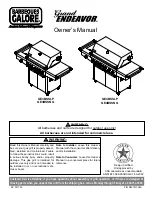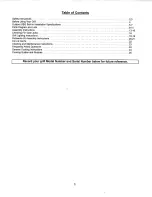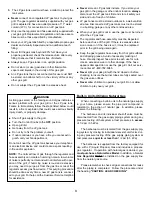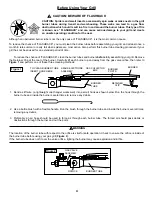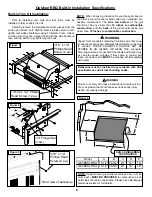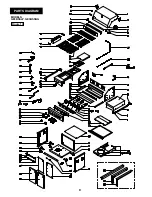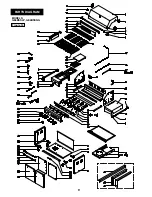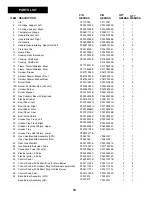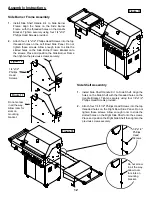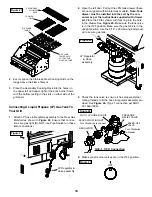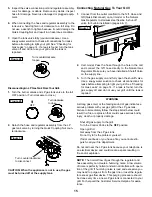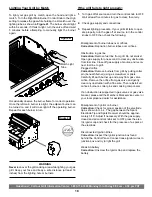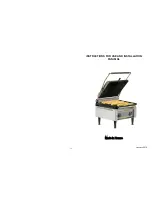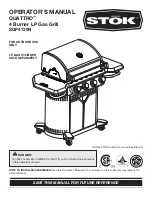
3
3.
The LP gas tank used must have a collar to protect the
tank valve.
Never
connect an unregulated LP gas tank to your gas
grill. The gas regulator assembly supplied with your gas
grill is adjusted to have an outlet pressure of 11" water
column (W.C.) for connection to an LP gas tank.
Only use the regulator and hose assembly supplied with
your gas grill. Replacement regulators and hose assem-
blies must be those specified by manufacture.
Have your LP gas tank filled by a reputable propane gas
dealer and visually inspected and re-qualified at each
filling.
Never fill the gas tank beyond 80% full. Have your
propane gas dealer check the release valve after every
filling to ensure that it remains free of defects.
Always keep LP gas tanks in an upright position.
Do not store (or use) gasoline or other flammable
vapors and liquids in the vicinity of this gas grill.
An LP gas tank that is not connected for use must NOT
be stored on bottom shelf or in the vicinity of this or any
other gas grill.
Do not subject the LP gas tank to excessive heat.
Never
store an LP gas tank indoors. If you store your
gas grill in the garage or other indoor location,
always
disconnect the LP gas tank first and store it safely out-
side and out of reach of children.
LP gas tanks must be stored outdoors in a well-ventilat-
ed area. Disconnected LP gas tanks must not be stored
in a building, garage or any other enclosed area.
When your gas grill is not in use the gas must be turned
off at the LP gas tank.
The regulator and hose assembly must be inspected
before each use of the grill. If there is excessive abra-
sion or wear or if the hose is cut, it must be replaced
prior to the grill being used again.
Keep the gas regulator hose away from hot grill surfaces
and dripping grease. Avoid unnecessary twisting of
hose. Visually inspect hose prior to each use for cuts,
cracks, excessive wear or other damage. If the hose
appears damaged do not use the gas grill. Call our serv-
ice center at
1-800-752-3085
.
Never
light your gas grill with the lid closed or before
checking to insure the burner tubes are fully seated over
the gas valve orifices.
Never
allow children to operate your grill. Do not allow
children to play near your grill.
n
WARNING
A strong gas smell, or the hissing sound of gas indicates a
serious problem with your gas grill or the LP gas tank.
Failure to immediately follow the steps listed below could
result in a fire or explosion that could cause serious bodily
injury, death, or property damage.
Shut off gas supply to the grill.
Turn the Control Knobs to the
OFF
position.
Open grill lid.
Get away from the LP gas tank.
Do not try to fix the problem yourself..
If odor continues or you have a fire you cannot extin-
guish, call your fire department.
Do not call near the LP gas tank because your telephone
is an electrical device and could create a spark resulting
in fire and/or explosion.
NOTE:
The normal flow of gas through the regulator and
hose assembly can create a humming noise. A low volume
of noise is perfectly normal and will not interfere with oper-
ation of the grill. If humming noise is loud and excessive
you may need to purge air from the gas line or reset the
regulator excess gas flow device. This purging procedure
should be done every time a new LP gas tank is connect-
ed to your grill. For help call the Customer Service Helpline
for assistance.
Built-in Units Utilizing Natural Gas
When connecting a built-in unit to the natural gas supply
in your home, please ensure the pipe joint compound is
resistant to the action of natural gas. In addition, please
observe the following:
The barbecue and its individual shut-off valve must be
disconnected from the gas supply piping system during any
pressure testing of that system at test pressures in
excess
of 1/2 psi (3.5 kPa).
The barbecue must be isolated from the gas supply pip-
ing system by closing its individual manual shut-off valve dur-
ing any pressure testing of the gas supply piping system at
test pressures
equal to or less than
1/2 psi (3.5 kPa)
The barbecue is supplied from the factory equipped for
use with LP (Liquid Propane) Gas and includes a propane
gas regulator. If operation with natural gas is desired, you
must purchase a Natural Gas Model.
In addition, a Natural
Gas Regulator MUST
be installed on the gas supply line
from the natural gas source.
Please remember to check all gas connections for leaks
after the piping is completed. Follow the procedure under
the heading
"CAUTION: LEAK CHECKING."

